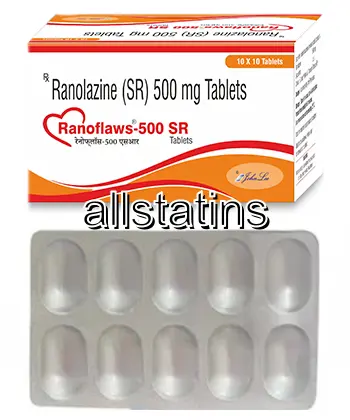| Package | Dosage | Price | Price per Dose | |
|---|---|---|---|---|
| Dosage: 500mg | ||||
| 180 pill | 500mg | AUD854.64 | AUD4.75 | |
| 120 pill | 500mg | AUD608.92 | AUD5.07 | |
| 90 pill | 500mg | AUD480.72 | AUD5.34 | |
| 60 pill | 500mg | AUD357.87 | AUD5.96 | |
| 30 pill | 500mg | AUD240.35 | AUD8.01 | |
| Dosage: 1000mg | ||||
| 180 pill | 1000mg | AUD961.47 | AUD5.34 | |
| 120 pill | 1000mg | AUD689.05 | AUD5.74 | |
| 90 pill | 1000mg | AUD582.22 | AUD6.46 | |
| 60 pill | 1000mg | AUD432.65 | AUD7.21 | |
| 30 pill | 1000mg | AUD256.37 | AUD8.55 | |

Ranolazine Description
What is Ranolazine?
Ranolazine is a prescription medication used to treat chronic angina in adults. It is not for sudden chest pain or a heart attack. It should be part of a complete treatment plan that includes healthy habits and other medicines as prescribed. You will usually take it twice a day, and your doctor will tailor the dose to your needs.
How does it work?
The active substance blocks late sodium current in heart cells under stress. This helps the heart muscle use oxygen more efficiently. By reducing the work of the heart in angina, episodes of chest pain may become less frequent and less intense. It can also help with exercise tolerance in some patients.
Who should consider it?
Ranolazine is usually prescribed for adults with stable, chronic angina when other medicines do not control symptoms well enough. It may be added when standard antianginal drugs do not provide enough relief. Your doctor will check liver function before starting treatment.
How to take it
The typical dose is 500 mg twice a day. Depending on response and liver function, a clinician may increase to 1000 mg twice daily. Do not exceed 2000 mg per day. Take tablets at the same times each day for best results. Do not split or crush extended-release forms if you have them, and swallow with a full glass of water.
Administration tips
You can take ranolazine with or without food. Do not crush or chew the tablets. If you miss a dose, take it as soon as you remember unless it is nearly time for the next dose. Do not double up. If you have trouble remembering, set a daily reminder or use a pill organizer.
What to expect and safety notes
Ranolazine does not relieve an acute angina attack. It may take several weeks to notice a steady improvement in symptoms. Common side effects include dizziness, headache, constipation and nausea. If you notice fainting, rapid heartbeat, or severe chest pain, contact a clinician promptly.
Drug interactions and warnings
Ranolazine is processed by liver enzymes. Strong inhibitors or inducers of these enzymes can raise or lower levels in the blood. Avoid using with medications that prolong the QT interval. This includes certain antibiotics, antifungals, antiarrhythmics and some antipsychotics. Tell your doctor about all medicines you take, including herbs and supplements. Do not start or stop any drug without professional advice.
Special considerations
Ranolazine should not be used in people with severe liver disease. People with long QT syndrome or other heart rhythm problems need careful monitoring. The drug may interact with alcohol or other substances; discuss with your clinician. Women who are pregnant or breastfeeding should seek guidance before use.
Monitoring and follow-up
Your doctor will track your response to therapy with visits and blood tests if needed. They may adjust the dose based on symptoms and any side effects. Do not stop the medicine abruptly unless advised by a clinician. Regular monitoring helps keep the treatment safe and effective.
Online pharmacy note
When buying ranolazine online, please provide your medical history and current medications to ensure safety. Always verify the source is legitimate, and follow the dosing instructions provided by your pharmacist. This information is for guidance and does not replace a doctor’s advice.
